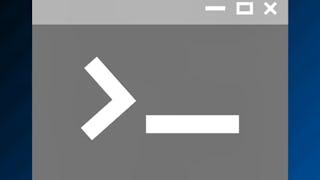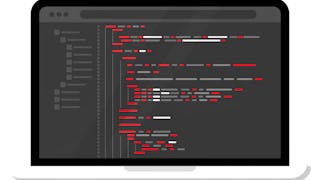This course is designed to explore how to execute Python locally and organize and use code across different Python files. Learners will learn how to read and write different types of files, use subprocesses and input streams, create Bash scripts, and use regular expressions. This course also covers automatic testing and explains how to set up a developer environment on a personal machine.
通过 Coursera Plus 解锁访问 10,000 多门课程。开始 7 天免费试用。


Using Python to Interact with the Operating System
本课程是 Google IT Automation with Python 专业证书 的一部分
290,763 人已注册
包含在 中
您将学到什么
Setup, configure, and use your own developer environment in Python
Manipulate files and processes running on the Operating System using Python
Understand and use regular expressions (regex), a powerful tool for processing text files
Know when to choose Bash or Python, and create small scripts using Bash
您将获得的技能
要了解的详细信息

添加到您的领英档案
24 项作业
了解顶级公司的员工如何掌握热门技能

积累 Support and Operations 领域的专业知识
- 向行业专家学习新概念
- 获得对主题或工具的基础理解
- 通过实践项目培养工作相关技能
- 通过 Google 获得可共享的职业证书

该课程共有7个模块
In this module, you’ll learn about the different types of operating systems, and how you can get your python code ready to interact with the operating system. We’ll learn about getting your environment set up and installing additional Python modules that will help you along the way. We’ll rundown interpreted versus compiled language, and how they differ from each other. We’ll dive into the benefits of automation, and point out common pitfalls so you can avoid them. Finally, we’ll learn about Qwiklabs, which will be used for graded assessments.
涵盖的内容
15个视频6篇阅读材料4个作业
In this module, you’ll learn about reading and writing to files and the commands that will enable you to do this. We’ll learn the importance of managing files and how we can navigate through different directories. You’ll understand how to work with files and how there is a layer of abstraction between Python and the operating system. Finally, we’ll dive into learning about CSV files and how to best utilize them.
涵盖的内容
15个视频16篇阅读材料4个作业1个应用程序项目1个非评分实验室
In this module, you’ll learn about what a regular expression is and why you would use one. We’ll dive into the basics of regular expressions and give examples of wildcards, repetition qualifiers, escapare characters, and more. Next up, we’ll explore advanced regular expressions and deep dive on repetition qualifiers. You’ll tackle new exercises like capturing groups and extracting PIDs using regexes. Finally, we’ll provide a study guide to serve as your go-to guide for regular expressions.
涵盖的内容
14个视频14篇阅读材料4个作业1个应用程序项目
In this module, you’ll learn about reading and writing to data files based on an interaction with the user. Along the way, we’ll dive into standard streams, environment variables, and command line arguments. Next, we’ll jump into Python subprocesses, including system commands and how they can be used. We’ll review how to obtain output from a system command, and dive into subprocess management, including how to check exit values and manipulate the normal versus error exit values. Finally, we’ll rundown processing log files, and will cover what a log file is, how to filter log files using regular expressions, and how to understand the output captured from log files.
涵盖的内容
12个视频13篇阅读材料4个作业1个应用程序项目
In this module, you’ll learn how to create tests in Python. We’ll cover what testing is all about and dive into the differences between manual versus automated testing. Next, we’ll explore what unit tests are intended to do and how to write them. Then, we’ll learn about other test concepts like black box versus white box tests and how test-driven development can frame how you design and write your code. Finally, you’ll learn about errors and exceptions, and how to combat them.
涵盖的内容
14个视频16篇阅读材料3个作业1个应用程序项目2个非评分实验室
In this module, you’ll be exposed to what the Linux OS has to offer and you'll learn about Bash scripting. We’ll go over basic Linux commands and explore the many processes Linux has to offer, including a key concept called redirection. We’ll then deep dive into creating Bash scripts using variables and globs. Finally, we’ll learn about advanced Bash concepts and develop an understanding of when to use Bash versus Python.
涵盖的内容
13个视频17篇阅读材料4个作业1个应用程序项目
In this module, you’ll put everything you’ve learned so far into action! You’ll apply your scripting knowledge to tackle a challenging final project: writing a script that scans for a specific error in the log files. You'll create a problem statement to understand the challenge, conduct some research to see what options are available, then begin planning how you intend to solve the problem. Lastly, you'll write the code to implement your solution!
涵盖的内容
6个视频3篇阅读材料1个作业1个应用程序项目
获得职业证书
将此证书添加到您的 LinkedIn 个人资料、简历或履历中。在社交媒体和绩效考核中分享。
位教师

提供方
从 Support and Operations 浏览更多内容
 状态:免费试用
状态:免费试用 状态:免费试用
状态:免费试用
Duke University
 状态:预览
状态:预览
人们为什么选择 Coursera 来帮助自己实现职业发展




学生评论
6,607 条评论
- 5 stars
78.24%
- 4 stars
15.86%
- 3 stars
3.49%
- 2 stars
1.27%
- 1 star
1.13%
显示 3/6607 个
已于 Mar 1, 2021审阅
the course is great, the material is great, the instructor is great, I love Roger because he teaches me in a very light way to deliver the content, plus I love his joke, thanks, Roger!
已于 Jul 8, 2020审阅
It is a wonderful course, I've learned a lot within the classes, and I am ready to use this knowledge to develop my own projects. It a little bit extensive, but to accomplish it is rewarding.
已于 Oct 8, 2020审阅
Generally good course, but comparing to the Crash course on Python reading materials were simply links to Python docs till the very end. Nonetheless, I learned so much here. Thank you!
常见问题
To access the course materials, assignments and to earn a Certificate, you will need to purchase the Certificate experience when you enroll in a course. You can try a Free Trial instead, or apply for Financial Aid. The course may offer 'Full Course, No Certificate' instead. This option lets you see all course materials, submit required assessments, and get a final grade. This also means that you will not be able to purchase a Certificate experience.
When you enroll in the course, you get access to all of the courses in the Certificate, and you earn a certificate when you complete the work. Your electronic Certificate will be added to your Accomplishments page - from there, you can print your Certificate or add it to your LinkedIn profile.
更多问题
提供助学金,



